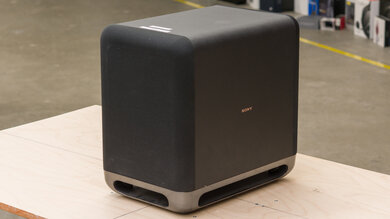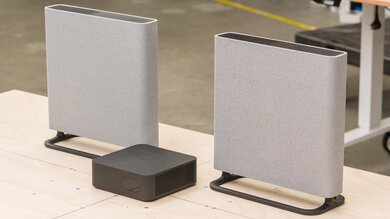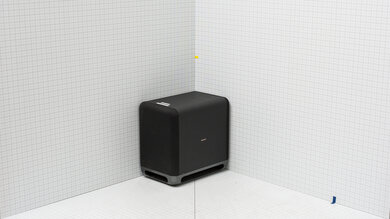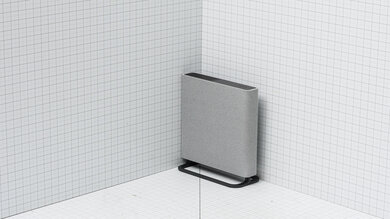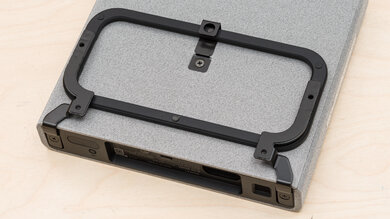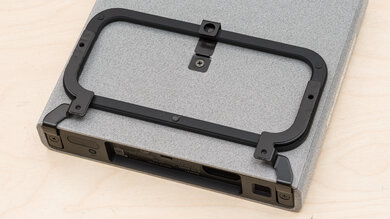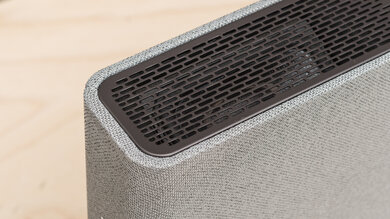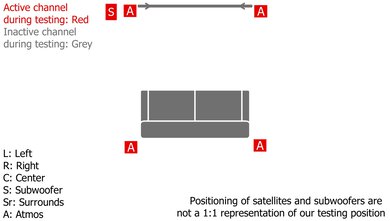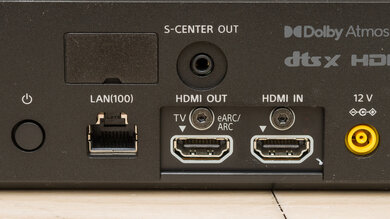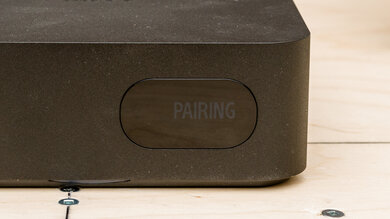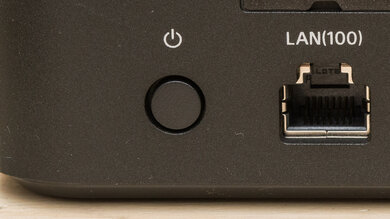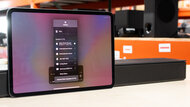The Sony BRAVIA Theater Quad with Bass Module is an Atmos-compatible home theater system made up of four satellite speakers, a dedicated subwoofer, and a control box. This setup is reminiscent of the Sony HT-A9 with Bass Module, though the speakers have taken on a more discrete, rectangular shape that can blend more easily into your home decor. They feature a unique dual stand/mount support, too, that can keep the speakers upright on any surface or allow them to be wall-mounted. As you'd expect from a premium system, there's support for HDMI 2.1, with 4k passthrough at 120Hz. BRAVIA TV owners will appreciate Sony's Acoustic Center Sync technology, which allows you to use the speakers on any compatible BRAVIA TV as a center channel.
Our Verdict
The Sony BRAVIA Theater Quad with Bass Module is good for mixed usage. The four discrete speakers create a wide, immersive soundstage, and they can be positioned to suit your room. Sony's Soundfield Optimization technology allows you to get the best out of your room, too, and the speakers are fitted with up-firing drivers that can help create the impression of height with Atmos content. The dedicated subwoofer adds punch and boom to everything from kick drums to low-frequency rumbles in action sequences, although some users might find the lack of EQ presets to be limiting. Gamers can take advantage of the HDMI 2.1 capabilities, too, using this setup as a hub through which to passthrough higher bandwidth (4k @ 120Hz) signals.
-
Room correction feature.
-
Immersive and wide soundstage.
-
HDMI 2.1 passthrough with 4k @ 120Hz.
-
Can't reach top volume without risking damage.
The Sony BRAVIA Theater Quad with Bass Module is very good for dialogue and TV shows. The four discrete speakers can render speech and other mid-frequency sounds crisply and evenly, and the 'Voice Mode' setting can be used to further bring out dialogue. While this system's configuration means there's no dedicated center channel, it's possible to use the Acoustic Center Sync technology to pair a compatible BRAVIA TV and use its speakers as a center channel. While it can get quite loud with minimal compression, we don't advise you to push the system to max volume, as it can damage the speakers.
-
Room correction feature.
-
Immersive and wide soundstage.
-
Voice and dialogue enhancement features.
-
Can't reach top volume without risking damage.
-
No dedicated center, unless you own a BRAVIA TV.
The Sony BRAVIA Theater Quad with Bass Module is great for music. The default sound is balanced, with detailed mids and warm highs, as well as a punchy bass that's courtesy of the dedicated subwoofer. The four discrete speakers are able to create a wide, immersive soundstage, too, that can really showcase creative panning and binaural flourishes in mixes. While it can get quite loud with minimal compression, we don't advise you to push the system to max volume, as it can damage the speakers.
-
Room correction feature.
-
Immersive and wide soundstage.
-
Voice and dialogue enhancement features.
-
Can't reach top volume without risking damage.
-
No EQ or presets.
The Sony BRAVIA Theater Quad with Bass Module is very good for movies. The default frequency response is balanced across the entire range, as the dedicated sub adds punch and heft to action sequences and explosions, while the four discrete speakers reproduce dialogue and voices with width and accuracy. The four-speaker configuration makes for an immersive soundstage with great surround performance, bolstered by Sound Field Optimization technology that tunes the surround response to the unique characteristics of your room. While this system is capable of getting quite loud with minimal amounts of compression, we don't recommend you to push the system to max volume, as it can damage the speakers.
-
Room correction feature.
-
Immersive and wide soundstage.
-
Voice and dialogue enhancement features.
-
Can't reach top volume without risking damage.
-
No dedicated center, unless you own a BRAVIA TV.
- 8.0 Mixed Usage
- 7.9 Dialogue/TV Shows
- 8.1 Music
- 7.9 Movies
Changelog
-
Updated Jan 30, 2025:
We referenced the Sony BRAVIA Theater Quad in the Dimensions - Subwoofer box.
- Updated Aug 12, 2024: We've made a minor text edit to the Voice Assistant box to clarify that voice assistant support is reliant on being connected to a third-party device.
- Updated Aug 05, 2024: We've updated this review to indicate that the Sony BRAVIA Theater Quad + Bass Module doesn't feature built-in Chromecast support.
- Updated Aug 01, 2024: We've updated the pros/cons section of this review. While it can get quite loud, pushing it to its max volume resulted in a speaker breaking, which we consider a con.
- Updated Jul 31, 2024: Review published.
Check Price
Differences Between Sizes And Variants
The Sony BRAVIA Theater Quad with Bass Module only comes in one color variant 'Gray.' You can see our unit's label here. It's worth mentioning that this is our second unit, as our first unit broke while testing the Max SPL. You can read more about this in Stereo Dynamics. If you encounter another variant of this soundbar, let us know in the comments, and we'll update our review.
Compared To Other Soundbars
The Sony BRAVIA Theater Quad with Bass Module is a system of four discrete speakers that comes with a dedicated subwoofer and control box. It's similar in configuration to the Sony HT-A9 with Bass Module, though the design of the speakers has been changed so that they're flat and rectangular and can more easily be placed on surfaces or wall-mounted. While there are similarities in performance and feature set, there are some trade-offs, too. The Theater Quad has a better default frequency response and a better stereo dynamics performance. While we don't expect most users to do this, pushing the volume to max volume can result in the speaker's malfunctioning, as detailed in the Stereo Dynamics test. While both systems feature HDMI 2.1 compatibility, with 4k passthrough @ 120Hz, the Theater Quad's latency performance leaves a lot to be desired and might require some tweaking of the AV Sync feature. For this reason, the HT-A9 has the edge if you plan on using your setup for gaming.
See our recommendations for the best soundbars, the best Sony soundbars, and the best Dolby Atmos soundbars.
The Samsung HW-Q990D and the Sony BRAVIA Theater Quad with Bass Module are both top-of-the-line offerings from their respective manufacturers. The Sony is configured as four discrete speakers with a subwoofer and control box, whereas the Samsung is an 11.1.4 setup with a subwoofer, two satellite speakers, and a more conventional bar at the center. While both setups are good options for a home theater system, the Samsung represents better value. It has a more balanced default frequency response, with more sound enhancement options, plus it can get louder with less compression. The Sony's configuration means that it has a wider, more immersive soundstage, but this comes at the expense of clarity in the center. The Sony is also hampered somewhat by high latency across all connection types, which could prove troublesome for gamers.
Depending on the types of media you mainly consume, either the Sony BRAVIA Theater Quad with Bass Module or the Sonos Ultimate Immersive Set with Arc Ultra may be a preferable choice, as they each have different strengths. The Sony has a wider stereo soundstage, though this depends on how far apart you place its speakers, and it has better connectivity so you can use it as an entertainment hub, thanks to its HDMI 2.1 In port for passthrough. On the other hand, the Sonos gets louder and doesn't compress as much. It also has a discrete center channel, ensuring dialogue sounds clearer and more accurate out of the box. Both soundbars are fairly evenly matched unless you want the Sony's greater connectivity and slightly better format support, though it's easier to add other speakers by the manufacturer to the Sonos.
The Sony BRAVIA Theater Quad with Bass Module is a bit better than the Sony BRAVIA Theater Bar 9 with Speakers + Bass Module for most people. The dedicated four-speaker and sub bundle of the BRAVIA Theater Quad creates a more immersive surround sound experience and a bigger stereo soundstage with slightly better dynamics. On the other hand, if you watch a lot of dialogue-heavy media, the dedicated center channel of the BRAVIA Theater Bar 9 reproduces clearer speech. That said, the clarity of the BRAVIA Theater Quad's surround speakers is worth it for most people, given that neither comes with an equalizer.
The Sony BRAVIA Theater Quad with Bass Module is the successor to the Sony HT-A9 with Bass Module. The most immediate difference is in the design of the discrete speakers. The previous generation's were cylindrical and bulky, while the newer model opts for a sleek, rectangular design with dual-function mounts/stands. The Bass Module (subwoofer) remains the same. While there are similarities in performance and features, there are some trade-offs, too. The Theater Quad has a better default frequency response and a better stereo dynamics performance, which is a great fit for movies. That said, pushing the volume too high can result in the speaker's malfunctioning. While both systems feature HDMI 2.1 compatibility, with 4k passthrough @ 120Hz, the Theater Quad's latency performance isn't the best and might require some tweaking of the AV Sync feature. For this reason, the HT-A9 has the edge if you plan on using your setup for gaming.
The Sony BRAVIA Theater Quad with Bass Module and the Nakamichi DRAGON are both solid options for home theater setups with slightly different strengths. The Sony is better built, and its quad-speaker design means that you can easily arrange the system around your living room, aided by easy-to-use mounting brackets. It has a more balanced default sound and an extremely wide, spacious soundstage. That said, the Nakamichi has a better center channel performance and can get much louder without compressing as much. The considerable size and weight of the Nakamichi's components make it more challenging to fit into the average living room. Both bars feature HDMI 2.1 with 4k passthrough at 120Hz, but the Nakamichi features three HDMI In ports.
The Sony BRAVIA Theater Bar 9 is a compact, standalone bar that's a good solution if you lack the space for a large setup. That said, if you have the space and budget, it's worth opting for the Sony BRAVIA Theater Quad with Bass Module instead. It's got a more balanced frequency response, with a thumpier bass, thanks to its dedicated subwoofer. The surround sound and height performance with Atmos content is also a step up, thanks to the four discrete speakers with up-firing drivers. The Theater Quad lacks a discrete center, with its satellite speakers creating a phantom center instead. As a result, it lacks focus compared to the Theater Bar 9, so dialogue and speech can seem a little pushed back and lacking detail.
The Sony BRAVIA Theater Quad is identical to the Sony BRAVIA Theater Quad with Bass Module, just without the subwoofer. Naturally, that means the former offers less low-bass thump and punch, so sound effects and cinematic scores sound a bit thin. That said, if you're happy to save a little money, or already have this bass module from purchasing the Sony HT-A9 with Bass Module, you might be fine without the additional sub.
The Sonos Ultimate Immersive Set with Arc and the Sony BRAVIA Theater Quad with Bass Module are both premium home theater setups. The Sonos features a 7.1.4 setup with a Sonos Arc, Sonos Sub, and two Sonos Era 300 speakers. By contrast, the Sony features four interchangeable speakers, a subwoofer, and a control box. Both systems have a very similar default frequency response, but the Sonos can get a little louder with minimal compression. With the Sonos Arc as its core, it also has a discrete center rather than the Sony's phantom center. That said, the Sony produces a wider, more immersive sound with better surround sound and height performance. It also features HDMI 2.1 compatibility and the ability to passthrough high-resolution signals, like 4k @ 120Hz. Conversely, the Sonos doesn't have an HDMI In port or Bluetooth compatibility but does offer a lower latency performance across both HDMI and ARC.
Video
Test Results
The Sony BRAVIA Theater Quad with Bass Module has an interesting design, eschewing the usual bar format for four speakers that can be positioned around your room. The speakers are covered in a smooth, felt-like material that's easy on the eye. Their flat, squared design will polarize opinion, but it does make them blend into the wall when mounted. If you'd prefer to have them standing, they come with black metal stands that they can perch on. These stands can also be reconfigured as mounting brackets if you do choose to wall-mount them. A small control box is also used to link the speakers and subwoofer. The location of the power cable port can make connecting these speakers a bit of a challenge, though, as they need to be inserted in the tight space between the stand and the speaker.
The subwoofer or bass module is the same as the one provided with the Sony HT-A9 with Bass Module (SA-SW5). The casing is made of a durable plastic with a leather-like exterior. There's a front-firing driver that's wrapped in a matte fabric, as well as a down-firing driver at the bottom of the enclosure.
The speakers are designed to be positioned on either side of your TV, rather than directly below it, like a conventional soundbar. As a result, this system can accommodate more or less any size TV. The speakers themselves don't take up much space but are a little wider than conventional satellite speakers.
This system has a bulky subwoofer that's a little larger than a typical desktop PC. If you don't need an additional subwoofer, consider the Sony BRAVIA Theater Quad.
The build quality is excellent. The speakers, control box, and subwoofer are all primarily constructed of durable plastic, and the sub has a faux leather-like texture. The speakers are covered in a tight mesh, which is also used to cover the front driver of the sub. The control box feels solid and slightly more substantial than the one supplied with the Sony HT-A9 with Bass Module.
This soundbar has a great stereo frequency response. The tuning is relatively balanced, with a punchy and well-controlled bass that doesn't overpower the detailed mids and smooth highs. We tested its performance on Standard Surround mode with Sound Field Optimization enabled, and no tweaks to the EQ.
The Sound Field Optimization feature that comes with this setup runs automatically when you first set it up, but you can also manually re-run it if you move the speakers or change rooms. It's designed to optimize the sound according to the acoustics of your room. While we tested with this function enabled, you can see how it performs without it here, as well as with 'Night Mode' and 'Voice Mode' enabled. Subjectively, we found that the Sound Field Optimization pushed the sound forward, adding a more immersive quality to the soundstage.
Some users might also want to position the speakers so they lie (or are mounted) on their side, to see how this affects the frequency response for both Atmos and Surround Sound formats.
Upon initially receiving the unit, we found that there was no option to adjust the subwoofer level in the app. However, upon updating the bar to the latest firmware, we found that the bass level could be adjusted from -10 to +10. That said, if you prefer a more neutral sound profile, we'd recommend keeping the default settings.
Unlike other soundbars, the soundstage of the Sony BRAVIA Theater Quad with Bass Module can extend well beyond the width of your TV, depending on how you choose to place the speakers. As a result, this setup yields amazing width with good focus between the two front speakers. You still need to be careful about how you position the speakers, though, as a particularly wide spacing can create a gap in the middle of the soundstage, even after calibration.
The Sony BRAVIA Theater Quad with Bass Module has a good dynamics performance. By default, the 'Audio DRC' setting is set to 'Auto,' so we disabled this before testing. It can get loud enough to fill a medium-sized room with sound, and there's minimal compression at max volume.
That said, it's worth noting that the results we obtained are from a second unit of this bar we purchased. Our initial unit broke while we were conducting our dynamics testing at max volume, resulting in a muffled treble response. We had similar issues when cranking the second unit up to max volume, meaning we couldn't get an accurate result for the second unit's dynamics. While we don't expect users to use the bar at this kind of volume and wouldn't advise it, it's necessary for a number of our tests. For this reason, we've also had to provide an estimate for the max volume that's based on the performance of the first unit.
This bar's center performance is just okay, as you might expect from a system of four dispersed speakers. It uses the left and right speakers to create a phantom center instead, which sadly doesn't help much with the placement of voices within the soundstage.
You can also connect a compatible Sony BRAVIA TV to pair with this setup, so you can use the TV's speakers as a discrete center channel. We conducted subjective listening tests using the Sony BRAVIA 9 QLED (which has the highest scoring frequency response of any Sony TV we've tested at the moment of publication) but found the results to be disappointing. Dialogue sounded pushed back, and there was a general lack of focus and detail in the center channel. The overall sound was better when using just the left and right soundbar speakers. However, your experience may vary with different TVs.
The Sony BRAVIA Theater Quad with Bass Module has a great surrounds performance. The setup consists of four satellite-like speakers with discrete localization that are able to accurately represent surround objects in the soundstage. The result is an immersive sound that comes from all around you, rather than in front of you.
It's worth noting that our measurement for SPL at Max Volume has been left as an estimate. This is due to our initial unit breaking while testing the max SPL. Our replacement unit also broke during this process, so we were unable to compare the results from the new unit to the ones obtained from the first unit before it broke.
Overall, this system conveys height in Atmos content well. Each of the speakers has up-firing drivers that bounce audio from the ceiling to give the illusion of height. Generally speaking, this results in an immersive, well-localized sound with good elevation. Elevated sound objects like drones or planes passing overheard sound accurately located and contrast well with the rumble of explosions or engines that come from below.
As we noted in Stereo Frequency Response, our first unit broke during SPL Max Volume testing, resulting in a muffled treble response. While our second unit also broke during the same test, its frequency response wasn't as badly affected as the first unit. While the treble and the main driver of the left front speaker were affected, the up-firing drivers functioned as normal, so we were able to give our subjective impressions. This is also why we are only able to provide an estimate of the SPL at Max Volume.
This soundbar doesn't come with any presets, but you can toggle through a few different modes, including: 'Night Mode' (which compresses the audio and brings down the bass so as not to disturb others at night), 'Sound Field' (which optimizes the Surround Sound to your room), and 'Voice Mode' (which brings out speech and dialogue). While there's no EQ, you can adjust the bass level via the app.
The Sony BRAVIA Theater Quad with Bass Module comes with a variety of connectivity options. You can connect it to your TV via HDMI, though it lacks an optical port to connect to older TVs. There's an HDMI In port that supports HDMI 2.1, though, as well as an Ethernet port. Finally, for those that own a compatible BRAVIA TV, there's an S-Center Out port that lets you connect to the TV for Acoustic Center Sync, allowing your TV's speakers to function as a center speaker.
The Sony BRAVIA Theater Quad with Bass Module has excellent compatibility with standard surround sound formats like Dolby Digital via using HDMI ARC, as well as with object-based and lossless formats like Dolby Atmos and DTS:X.
The Sony BRAVIA Theater Quad with Bass Module supports standard surround sound formats like Dolby Digital via it's HDMI In, as well as object-based and lossless formats like Dolby Atmos and DTS:X.
Audio latency is okay via ARC, and it's not particularly low regardless of what audio format it's playing back. You could notice occasional lip-sync errors as a result, but you can always use the AV Sync feature in the companion app to manually compensate for any latency. That said, different TVs and apps compensate for latency differently.
This soundbar has a mediocre latency performance, regardless of which audio format it's playing back. It's particularly high when playing back Dolby Digital content, though. Fortunately, there's an AV Sync feature in the app that can help compensate for any lip-sync issues you encounter. That said, different TVs and apps compensate for latency differently.
This bar can act as a hub between your TV and devices like a gaming console or PC. As it supports HDMI 2.1, it can passthrough 4k signals at 120Hz and 8k at 60Hz. As with the Sony HT-A7000 with Speakers + Bass Module, there's support for HDMI VRR and ALLM passthrough, too.
The Sony BRAVIA Theater Quad with Bass Module features a wealth of connectivity options for connecting your devices wirelessly, including support for Apple AirPlay and Spotify Connect.
The remote is similar to other Sony remotes, although it has fewer buttons than the one that comes with the Sony HT-A9 with Bass Module. You can also use the companion app to adjust parameters, and you can see it in action here.
The Sony BRAVIA Theater Quad with Bass Module doesn't feature any built-in voice assistant support. That said, you can still activate it with your voice if you pair it with a third-party voice assistant device that's compatible with Amazon Alexa or Google Assistant.
Comments
Sony BRAVIA Theater Quad with Bass Module: Main Discussion
Let us know why you want us to review the product here, or encourage others to vote for this product.
Hi! We have placed our home entertainment system in our attic which has a vaulted ceiling so I wanted to ask you which sound system would be better for this kind of setup. In principle and considering we own Bravia TVs and that I am looking for an immersive soundstage I was looking for the Bravia Quad setup with a bass module as the main option but am also considering the Samsung HW990F as an alternative. Could you please advise which setup, in your opinion, will be able to create a better soundstage with the vaulted ceiling? I guess it will depend on which one of those two could correct better the ceiling slope with its software calibration and I fear this will have a bigger impact on Atmos but I will really appreciate you’d advice! Thanks a lot!
Hello! Help with personalized buying advice is something our experts offer only via our insider forums. We do have lots of self-service tools and recommendation articles that should be helpful as well though!
- 21010
Hi! We have placed our home entertainment system in our attic which has a vaulted ceiling so I wanted to ask you which sound system would be better for this kind of setup. In principle and considering we own Bravia TVs and that I am looking for an immersive soundstage I was looking for the Bravia Quad setup with a bass module as the main option but am also considering the Samsung HW990F as an alternative. Could you please advise which setup, in your opinion, will be able to create a better soundstage with the vaulted ceiling? I guess it will depend on which one of those two could correct better the ceiling slope with its software calibration and I fear this will have a bigger impact on Atmos but I will really appreciate you’d advice! Thanks a lot!
Would these be overkill for a small living room? It’s about 4 m from one end to the other
Hello! Help with personalized buying advice is something our experts offer only via our insider forums. We do have lots of self-service tools and recommendation articles that should be helpful as well though!
- 21010
Would these be overkill for a small living room? It’s about 4 m from one end to the other
- 21010
Hello, I have my Sony Bravia Theater Quad hooked up to my pc and my LGCX48 inch OLED TV/Monitor. I can get dolby atmos and all other audio streams except for DTS when having the pc directly plugged in to the tv and my audio from the quad into the earc, but when I play video games on my pc i can only get 2.0PCM. I even tried plugging my hdmi 2.1 cables from the PC into the input of HDMI 1 of the quad system. Can someone explain when i play games that support atmos or 5.1 i’m only getting 2.0pcm audio? Thanks
Hi philgoodz,
Hard to say for sure, it could be a few things. If you’re running on Windows, you may just need to install Dolby Access from the Microsoft Store and play a compatible game with Atmos support. For 5.1 surround, if you’re using the eARC port on the TV check that you’ve set Pass Through in the Audio Settings to Auto and not PCM. Then make sure your game is outputting 5.1 surround in the game settings.
Hope this helps!
Thanks, Matt
- 21010
Hello, I have my Sony Bravia Theater Quad hooked up to my pc and my LGCX48 inch OLED TV/Monitor. I can get dolby atmos and all other audio streams except for DTS when having the pc directly plugged in to the tv and my audio from the quad into the earc, but when I play video games on my pc i can only get 2.0PCM. I even tried plugging my hdmi 2.1 cables from the PC into the input of HDMI 1 of the quad system. Can someone explain when i play games that support atmos or 5.1 i’m only getting 2.0pcm audio? Thanks
Update: We referenced the Sony BRAVIA Theater Quad in the Dimensions - Subwoofer box.
- 21010



